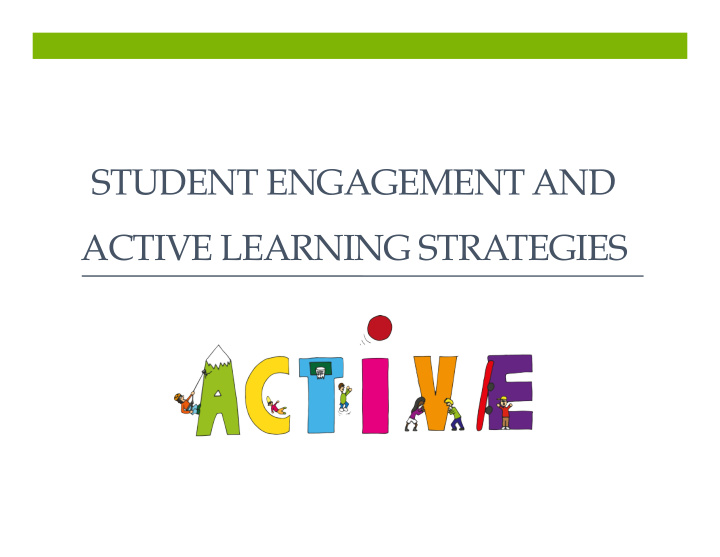



STUDENT ENGAGEMENT AND ACTIVE LEARNING STRATEGIES
Goal By the end of this session, you will have: Developed some ideas for active engagement in your classroom Planned the use of two collaboration tools in your classroom
Active Learning with the Flip What is Active Learning? Anything that students are doing in the classroom beyond passive listening; instructional method that engages students in the learning process Listening practices Short writing/problem-solving exercises Complex group problem-solving What are some strategies that you are currently using?
Engaging Students in the Flipped Classroom Why the Flip? Flipped allows faculty to be more thoughtful/ strategic in course delivery and active learning. Allows for faculty to engage students in higher levels of Bloom’s taxonomy (e.g., integration, synthesis). Flipped learning allows faculty to be more student- centric and to use more active learning strategies (and direct interaction to enhance engagement).
Engaging Students in the Flipped Classroom Core Considerations Inputs (demographics, previous experiences) Student’s current environments (college experiences) Outcomes (student characteristics, knowledge, attitudes, beliefs, values) How can these concepts affect the students’ engagement in the classroom?
Engaging Students in the Flipped Classroom • Four areas to think about when developing activities: Physical engagement: efforts and energy invested Cognitive engagement in class: focus on discussion, attention, concentration Cognitive engagement out of class: studying course material, absorbed by out of class activities Emotional engagement: excitement, pride in work, interest in course material
Engaging Students in the Flipped Classroom What strategies can be used? Physical engagement: Cognitive engagement in class: Cognitive engagement out of class: Emotional engagement:
Active Learning Strategies Individual Student Activities: One/five minute problem - pose a question and ask students to solve. Muddiest point - what was challenging from reading/out-of- class materials Reading/Clicker quiz - get feedback on student’s understanding of material Write a test question - students get actively involved in thinking about more complex problems Fishbowl- use notecards to give you ideas about muddiest point and then start next class with those challenges
Active Learning with the Flip Group Activities: Notes comparison/ sharing - students actively compare notes and fill in gaps of understanding Work at the board- students physically get up and move, shared problem-solving Gallery walk- teams share ideas and respond to meaningful questions, problem-solving situations or texts Jigsaw - each member of a group is asked to complete some discrete part of an assignment; when every member has completed his assigned task, the pieces can be joined together to form a finished project
Learning Objectives and Active Learning with the Flip Choose one basic learning objective and one advanced learning objective from the morning session Basic: Individual space activities- What activity best aligns with meeting this objective? Is it active? If not, how can it be transformed? Advanced: Group space activities- What activity best aligns with meeting this objective? Is it active? If not, how can it be transformed? Some examples: http://www.usf.edu/atle/documents/handout-interactive- techniques.pdf Share and critique…
Active Learning Tools Simple tools to help with active learning and engagement: LMS Moodle Wikis REEF iClickers, Choices, or Poll Everywhere/Top Hat Chats, Google hangouts- for conferencing with groups Google docs- for creating shared documents when there is no whiteboard Google forms- used for assessment of understanding
Active Learning Tools Advanced tools to help with active learning: Piazza - online problem-solving place where students can ask, answer, and explore questions under the guidance of their instructors (mix between wiki and forum), includes LaTex (equation editor) Slack: digital workspace, rich messaging system Voice Thread: collaborative tool, holds images, documents, and videos and allows people to navigate slides and leave comments in 5 ways - using voice, text, audio file, or video Padlet: online bulletin board with collaborative access (share links, ideas) EverNote/OneNote : interactive notetaking tools, allows for students to organize their notes, searchable
Active Learning Tools Explore some tools! Top 100 Tools for Education: http://c4lpt.co.uk/top100tools/top100-edu/ Pick two and think about how you would use them in your class. Appendix in Talbert’s Book Recommendations for the Flipped Classroom
Why work on Student Engagement? Student Outcomes: Good predictor of student learning and development Documented and significant relationship with learning outcomes Long-term impacts of student engagement in career satisfaction, earnings Faculty Outcomes: Why should we focus energy on this topic?
Final Thoughts… Does flipping and active learning reach all students? What are some obstacles for active learning in the Flipped approach? Pair-Strategize: How would you address these obstacles to increase student engagement? Strategies/Tools – Using technology always the best?
Recommend
More recommend